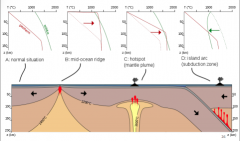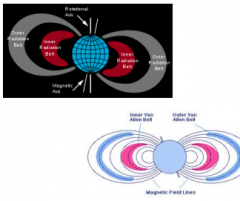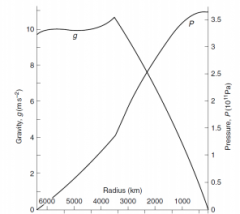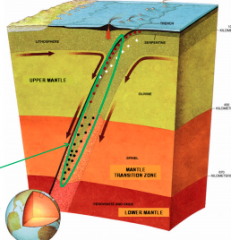![]()
![]()
![]()
Use LEFT and RIGHT arrow keys to navigate between flashcards;
Use UP and DOWN arrow keys to flip the card;
H to show hint;
A reads text to speech;
101 Cards in this Set
- Front
- Back
|
An Earthquake is:
|
a sudden, violent dislocation in the subsurface caused by stress buildup on a fault. The EQ is the RELEASE OF STRESS
|
|
|
Time Sequence of Elastic Rebound Theory (4)
|
1. BEFORE EQ
--> stress in crustal block slowly accumulates by tectonic forces 2. DURING EQ --> stress is released by motion on a new or pre-existing rupture or fracture zone (called a fault) 3. Immediately AFTER EQ --> crust rebounds to unstressed equilibrium position 4. FOLLOWING EQUILIBRIUM --> stress begins to re-accumulate slowly (tectonic forces have not stopped!) |
|
|
Elastic REbound Theory
|
Fence is straight, as plate moves is creates an "s" shape , EQ occurs and straight again but offset
|
|
|
FAults
|
- fault is a fracture or zone of fractures between two blocks of rock
- faults allow blocks to move rapidly (EQ) or slowly as a CREEP |
|
|
Location of Major Earthquakes
|
coincide with plate boundaries
- 90% of earthquakes occur near plate boundaries |
|
|
3 types of Faults
- Strike Slip Fault |
- occur where one plate slides past another plate (Turkey, Queen Charlotte, San Andreas)
--> all transform faults are strike slip faults .... but not all strike slip faults are transform faults** --> horizontal motion |
|
|
3 types of Faults
- Thrust (reverse) faults |
occur at subduction zones, where one plate rides under a second plate (Cascadia, Japan).
-These also are potentially the LARGEST. - Vertical Motion, upper block pushes up |
|
|
3 types of faults
- Normal Faulting |
tends to occur in tensional regimes, as seen in continental rifting (Basin and Range, East African Rift Zone)
-Vertical Motion, upper block drops down |
|
|
3 Plate Boundaries
- Divergent |
Normal Fault, occurs where plates are pulling apart under tension
|
|
|
3 types of plate boundaries
- Convergent |
Thrust (reverse) faults , occurs where plates are pushing together under compression, also converging lithosphere
|
|
|
3 types of plate boundaries
- Transform |
Strike-Slip Fault, occurs where plate are sliding past eachother
|
|
|
Wadati-Benioff Zone
|
Subduction zone of earthquakes running as deep as 660km into mantle
- occurs at convergent boundaries |
|
|
New Madrid Earthquake
|
did not occur at plate boundary.
|
|
|
What causes Earthquakes in Eastern Canada
|
Removal of Ice Load from glaciers
|
|
|
Focus
|
the location on a fault where Earthquake rupture initiates
|
|
|
Hypocentre
|
The calculated position of an earthquake focus
|
|
|
Epicentre
-epicentral distance |
That point on the Earth's surface directly above the hypocentre
- distance from epicenter to place of interest |
|
|
First Seismometer
|
invented in China, Chang Heng.
|
|
|
Earthquake epicentres are located by:
|
triangulation
|
|
|
Size of Earthquakes determined by: (2)
|
1. Instrument MAGNITUDE (richter scale)
2. felt INTENSITY (shaking) |
|
|
Magnitude
|
a measure of the strength of an earthquake, as determined by seismographic observations
-richter scale -surface-wave magnitude (most common) -moment magnitude |
|
|
Richter Scale
|
magnitude of earthquake determined from the logarithm of the amplitude of waves recorded by seismographs
Each whole number is 31 times more powerful (5 is 31x 4) |
|
|
Moment Magnitude - Mw
|
-most important magnitude scale for seismologists
-is a measure of energy release |
|
|
Intensity
|
scale to express damage
-measure of effects of an earthquake on natural or built environment -strongest at epicentre, lower farther away -Modified Mercalli intensity Scale (I-XII) |
|
|
Modified Mercalli Intensity Value
- I -III - VI -IX -XII |
I - not felt
III - felt indoors, vibration VI - Moderate, felt by all, glass breaks , furniture moves IX - Violent, cracks in ground, Heavy damage XII - damage near total, large rock displaced, objects thrown in air |
|
|
Volcanism (2)
|
Magma is melted rock beneath surface
- less dense liquid rises to erupt at the surface (LAVA) |
|
|
Source of Heat for Melting Rock
|
most of the heat that generates magma comes from Earth's core where temperatures are >5,000C
transported to surface through convection and conduction |
|
|
Melting
|
when a mineral is heated, its atomic vibration become more vigorous
if enough energy is provided, the ordering of atomic bonds holding the substance together will break and destroy the ordered structure of the substance |
|
|
Partial Melt
|
mix of melted and solid materials, because some minerals in rocks have different melting temperatures
|
|
|
Zone of Partial Melting for Peridotite
-Solidus -Liquidus |
- Solidus (melting curve)
--> the line of temperatures and pressures when PARTIAL melt begins -Liquidus --> the line of temperatures and pressures when the material becomes COMPLETELY MOLTEN |
|
|
Depth zone of Partial Melt
|
where the geothermal gradient intersects the solidus
Partial melt between 100km -250km |
|
|
Bowen's Reaction Series
|
Higher Sillica (SiO2) of a rock = lower melting pressure
|
|
|
SiO2
- 50% -60% -70% |
50% - mafic, 1100C, nonexplosive
60% - intermediate, 1000, intermediate 70% - felsic, 800, explosive |
|
|
Magma Differentiation
|
magma cools, mafic solidifies first and shrinks
felsic magma will rise |
|
|
Viscosity
|
measure of a fluids resistance to flow
-opposite of fluidity -materials that flow well, like water, have low viscosity -honey has HIGH viscosity |
|
|
Magma Viscosity
|
Viscosity of magma increases as temperature DECREASES
|
|
|
Silica SiO2 and Viscosity
|
chemical composition more important than temperature.
- SiO2 combines with elements to form FRAMEWORK STRUCTURES in the magma making it more viscous |
|
|
SAE 5W-40
|
5W
--> W = winter --> 40 is oil viscosity at operating temperature |
|
|
Explosiveness of Magma (3)
|
dissolved gasses stored under pressure below surface
- magma approaches surface pressure decreases, gas comes out and forms bubbles which push magma to surface - magma reaches the surface and becomes lava - Gas can escape more easily from low viscosity material -more violent eruptions occur when gases cant escape easily |
|
|
Degassing of magma created both: (2)
|
atmosphere and hydrosphere
|
|
|
3 ways to melt rock
|
1. Plume heating (intraplate -hotspots)
2. Decompression Melting (divergent boundaries) 3. Hydration Melting (convergent boundaries) |
|
|
Plume Heating (hotspots)
|
the arrival of a hot mantle plume raises the geotherm enough to melt
|
|
|
Effusive Eruptions
|
type of eruption that occur above hotspots
- Basaltic, Mafic |
|
|
Pahoehoe Lava
|
low viscosity basaltic lava
- rapid cooling of the surface lava forms a skin |
|
|
A'a Lava
|
jagged, rough surface
|
|
|
Decompression Melting (divergent boundaries)
|
high pressure in mantle reduce vibration and inhibit melting
|
|
|
DEcompression melting uner mid-ocean ridges
|
at spreading ridges, magma from mantle produces largest volume of new rock in the lithosphere
|
|
|
Lava at Divergent boundaries
|
mafic magma is generated through melting of Peridotite
- also creates basalt |
|
|
Hydration Melting (Convergent Boundary)
|
Presence of water, solidus (melting point of mantle) is shifted to lower temp.
|
|
|
Hydration Melting
-subduction zone volcanism occur |
subduction, magma driven by water in crust, lowers melting point of mantle wedge
|
|
|
Rocks at Convergent Plates
|
Andesite and Rhyolite
|
|

|
memorize
|
|
|
Lodestone
|
early chinese compass
- refers to natural magnet mineral -"south pointer" |
|
|
William Gilbert
|
birth of geomagnetism
|
|
|
Magnetic Dipole
|
a bar magnet generates a magnetic dipole
- magnetic poles, equal strength, equal distance. -monopole never been observed. |
|
|
Earth's Magnetic Field
|
3 dimensional field,
dipole but tilted |
|
|
Measuring Earth's Magnetic Field
- Inclination - Declination -Intensity |
Inclination
--> angle measured from horizontal, --> points into earth (dip angle) Declination --> angle measured from geographic north Intensity --> magnetic field strength (nT) |
|
|
Earth's Magnetic Field Generated
|
- high temperatures destroy magnetism
- minerals exceed Curie temp, they lose permanent magnetism |
|
|
Maxwell's Equations
|
foundation of electromagnetic theory
- a changing MAGNETIC field creates an electric field - a changing ELECTRIC field creates a magnetic field |
|
|
Magnetic Dipole
|
generated by a current loop
|
|
|
Geomagnetic Field
|
Dynamic field,
- source is in Earth's outercore - motion of molten metal |
|
|
Thermal Convection in Outer Core (3)
|
- heat transfer from inner core to outer core
- some released due to freezing of inner core -some radioactive |
|
|
Compositional Convection in the Outer Core
|
Inner Core is made of solid Fe and is growing due to freezing of the liquid outer core
due to low density, light elements rise in the outer core creating convection cells Dominant Cause!! |
|
|
Glatzmer-Roberts model
|
first computer model of the geodynamo
|
|
|
Earths Field is the sum of 3 parts:
|
1. Main Magnetic field
2. External Magnetic Field 3. Induced Magnetic Field |
|
|
Solar Wind
|
- charged particles ejected from the Sun |
|
|
Magnetosphere
|
zone where charges particles are affected by Earth's magnetic field
|
|
|
Magnetotail
|
portion of magnetosphere that is pushed away from the sun by the solar wind
|
|
|
Aurorae
- purplish red - yellowish green |
northern and southern lights
- purple - nitrogen - yellow - oxygen |
|

|
Van Allen Radiation Belts
|
|
|
Temporal Variation in Earth's Magnetic Field
|
geomagnetic field changes constantly from milliseconds to millions of years
|
|
|
Short Time Scale Variation Earth's Magnetic Field (2)
|
1. geomagnetic storms
--> interaction with the solar wind and Earth's magnetosphere 2. ionospheric fields --> 80 - 200km altitude above Earth charged ions move around by differential heating and lunar tides. movement created own magnetic fields interact with Earth |
|
|
Long Time Scale Variation in Earth's Magnetic Field
|
Secular Variation
- large changes in geomagnetic field |
|
|
Change in Geomagnetic Field Intensity
|
secular variation over ONE YEAR of the VERTICAL component of magnetic field
|
|
|
Discovery of Magnetic North Pole
|
Northwest Passage exploration by John Ross
|
|
|
How do we know the properties of geomagnetic field in the past?
|
Paleomagnetism
--> igneous/metamorphic rock cool below their CURIE temperature, they lock in the prevailing geomagnetic field at that TIME and LOCATION --> sedimentary rocks can get magnetization through magnetic particle orientation |
|
|
History of Geomagnetic Field led to 3 phenomena
|
1. Polar Wandering
2. Reversals of the geomagnetic field 3. The seafloor as a magnetic tape recorder |
|
|
Geomagnetic Reversal
|
change in Earth's magnetic field, the position of magnetic north and south are interchanged
- originates in outer core |
|

|
Field Reversal preserved in Lava Flow
|
|
|
Reversal Era's
- Now - Before - Boundary between |
Now - Brunhes (normal)
Before - Matuyama Reversed Chron Boundary between called - Brunhes -Matuyama |
|
|
Morler, Vine and Matthews
|
Magnetic stripes on ocean floor
-seafloor spreading |
|
|
Geomagnetic Excursion (or jerk)
|
field begins to change but maintains its polarity
|
|
|
Gravity
|
- Monopole
- Gravity is nearly equal everywhere on Earth and points to centre |
|
|
Newtons Universal Law of Gravitation
F = G = M, m = masses r = distance between the 2 objects |
F = force of gravity
G = universal Gravitational constant (6.67x10 M, m = masses of 2 objects r = distance between the 2 objects |
|
|
g of Earth's Surface
|
9.81m/s^2
|
|
|
Gravitational Acceleration at the ISS
|
g = 8.62 m/s^2
|
|

|
Gravity Variation with Depth
The deeper you go you only feel the gravity from what is beneath you |
|
|
Variation of Gravitational Acceleration with Latitude (3)
|
1. latitudes near the equator, have a outward centrifugal force produced from rotation. (less force of gravity slightly)
2. Earth's Equatorial bulge --> objects at the equator to be farther from the planets centre 3. more mass at the equator --> increase in gravity (weigh more at the poles than the equator) |
|
|
Isostasy
|
different topographic heights on the Earths Surface
- concept of rigid crust everywhere seeking to be supported equally by underlying asthenospheric mantle -Archimedes Principle |
|
|
Archimedes Principle
|
any object completely or partially submerged in a fluid is buoyed up by a force whose magnitude is equal to the weight of the fluid displaced by the object
|
|
|
Icebergs mass
|
mass of ice below water proportional to mass above
|
|
|
Isostasy and elevation of continental crust
-higher elevation - lower elevation |
Higher
- result from thicker or less dense crustal rocks Lower - thinner or more dense rock |
|
|
Principle of Isostasy
- |
densities different but WEIGHS THE SAME
|
|
|
Post Glacial Rebound
|
asthenosphere has bending, we feel the rebound pushing the ground up. feels like earthquake but not at plates
|
|
|
Isostatic Adjustment
|
Isostatic adjustment due to erosion and deposition of sediment. Rock within the mantle must flow to accommodate the vertical motion of crustal blocks
|
|
|
Isostatic Equilibrium
- Back to Block Model |
-Back to Block
--> if blocks neither sinking nor rising then they are at ISOSTATIC EQUILIBRIUM |
|
|
Are Mountains Isostatic
|
Mantle is viscous
- not in isostatic equilibrium (still rising) |
|
|
Isostatic Equilibrium and Glaciers
Problem? |
weight of ice pushes crust deeper into mantle
-warmer climate melts ice, bounces back up Problem? --> mantle much more viscous than ice and water. Mantle takes long to flow back and push crust up. |
|
|
Isostatic (post-Glacial) Rebound : Time Lag
|
Earth subsists into the mantle during glaciation and rebounds back when ice is removed
--> isostatic uplift |
|
|
Faults activated by post=glacial isostatic rebound?
|
uplift in Canada is consistent with glacial isostatic adjustment
yes |
|

|
Wadati Benioff Zone
|

